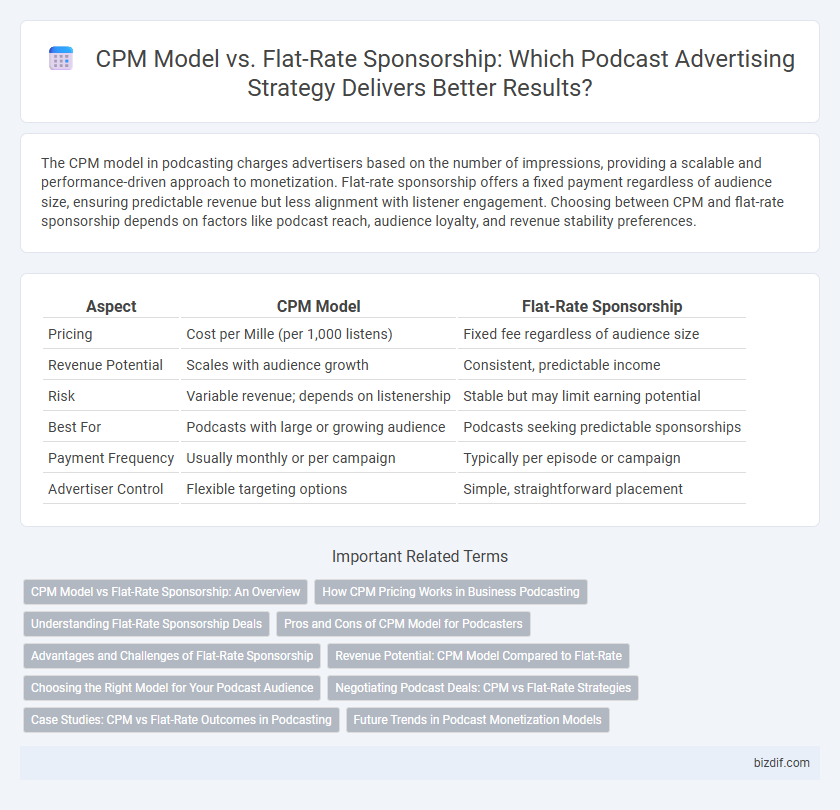The CPM model in podcasting charges advertisers based on the number of impressions, providing a scalable and performance-driven approach to monetization. Flat-rate sponsorship offers a fixed payment regardless of audience size, ensuring predictable revenue but less alignment with listener engagement. Choosing between CPM and flat-rate sponsorship depends on factors like podcast reach, audience loyalty, and revenue stability preferences.
Table of Comparison
| Aspect | CPM Model | Flat-Rate Sponsorship |
|---|---|---|
| Pricing | Cost per Mille (per 1,000 listens) | Fixed fee regardless of audience size |
| Revenue Potential | Scales with audience growth | Consistent, predictable income |
| Risk | Variable revenue; depends on listenership | Stable but may limit earning potential |
| Best For | Podcasts with large or growing audience | Podcasts seeking predictable sponsorships |
| Payment Frequency | Usually monthly or per campaign | Typically per episode or campaign |
| Advertiser Control | Flexible targeting options | Simple, straightforward placement |
CPM Model vs Flat-Rate Sponsorship: An Overview
The CPM model in podcasting charges advertisers based on the number of impressions, typically calculated per thousand downloads, allowing for scalable and performance-driven ad pricing. Flat-rate sponsorship involves a fixed fee regardless of audience size or ad performance, offering predictable costs but less alignment with listener reach. Choosing between CPM and flat-rate depends on campaign goals, with CPM favored for measurable ROI and flat-rate preferred for simplicity and brand-building efforts.
How CPM Pricing Works in Business Podcasting
CPM pricing in business podcasting operates on a cost-per-thousand-impressions basis, where sponsors pay based on the number of listens or downloads an episode receives. This model allows advertisers to directly correlate their spending with audience size and engagement metrics, ensuring measurable return on investment. Unlike flat-rate sponsorships, CPM pricing offers scalability and performance-based flexibility, aligning advertising costs with campaign reach and effectiveness.
Understanding Flat-Rate Sponsorship Deals
Flat-rate sponsorship deals offer podcasters a fixed payment regardless of listener numbers, providing predictable income and simplified billing compared to CPM models, which base earnings on cost per thousand impressions. This model benefits smaller or niche podcasts with loyal audiences by eliminating fluctuations tied to download metrics. Sponsors gain direct access to targeted listeners without worrying about varying ad performance or reach.
Pros and Cons of CPM Model for Podcasters
The CPM (Cost Per Mille) model offers podcasters revenue based on ad impressions, providing scalability as audience size grows. This performance-driven approach ensures earnings correlate directly with listenership, but requires consistently high download numbers to maximize income. However, fluctuations in listener engagement and ad-blocking technologies can lead to unpredictable earnings compared to the steadier income from flat-rate sponsorships.
Advantages and Challenges of Flat-Rate Sponsorship
Flat-rate sponsorship offers podcasters predictable revenue by charging a fixed fee regardless of audience size or impressions, simplifying budgeting and contract negotiations for both parties. This model ensures consistent income without reliance on fluctuating CPM rates but may limit earnings potential if the podcast rapidly grows in listenership. Challenges include the risk of undercharging for highly engaged audiences and difficulty in aligning sponsorship value with actual listener metrics compared to performance-based CPM approaches.
Revenue Potential: CPM Model Compared to Flat-Rate
The CPM model maximizes revenue potential by aligning earnings with actual listener engagement and episode downloads, allowing podcasters to scale income as their audience grows. Flat-rate sponsorships provide predictable revenue but often limit earnings to a fixed amount regardless of audience size or episode performance. Podcasters with rapidly expanding or highly engaged audiences typically benefit more financially from the CPM model compared to flat-rate agreements.
Choosing the Right Model for Your Podcast Audience
Choosing the right sponsorship model depends on your podcast's audience size and engagement levels; CPM (Cost Per Mille) is ideal for larger audiences with measurable impressions, providing revenue based on every thousand listens or downloads. Flat-rate sponsorship suits niche or smaller podcasts with loyal listeners, offering predictable income regardless of listenership fluctuations. Evaluating listener demographics, episode reach, and advertiser goals helps tailor a sponsoring strategy that maximizes revenue and maintains audience trust.
Negotiating Podcast Deals: CPM vs Flat-Rate Strategies
Negotiating podcast deals requires understanding the CPM model, which charges advertisers based on every thousand listens, aligning payments directly with audience size and engagement metrics. Flat-rate sponsorships offer a fixed fee regardless of download numbers, providing predictable revenue but less flexibility tied to actual listener performance. Evaluating audience demographics and growth trends helps podcasters decide whether CPM or flat-rate strategies maximize monetization and advertiser value.
Case Studies: CPM vs Flat-Rate Outcomes in Podcasting
Case studies comparing CPM (Cost Per Mille) models with flat-rate sponsorships in podcasting reveal distinct financial and engagement outcomes. CPM models often provide scalable revenue aligned with audience size, while flat-rate sponsorships guarantee consistent income irrespective of listenership fluctuations. Data indicates podcasts with stable, niche audiences benefit more from flat-rate deals, whereas those with growing listenership maximize earnings through CPM-based monetization strategies.
Future Trends in Podcast Monetization Models
The CPM model continues to dominate podcast monetization by offering advertisers precise audience targeting and performance metrics, driving increased ad spend. Flat-rate sponsorships are evolving with more customized, brand-integrated content that enhances listener engagement and long-term partnerships. Future trends indicate a hybrid approach leveraging real-time data analytics and dynamic ad insertion to maximize revenue while maintaining authentic listener experiences.
CPM Model vs Flat-Rate Sponsorship Infographic

 bizdif.com
bizdif.com